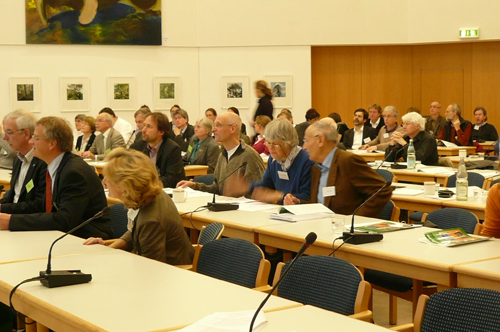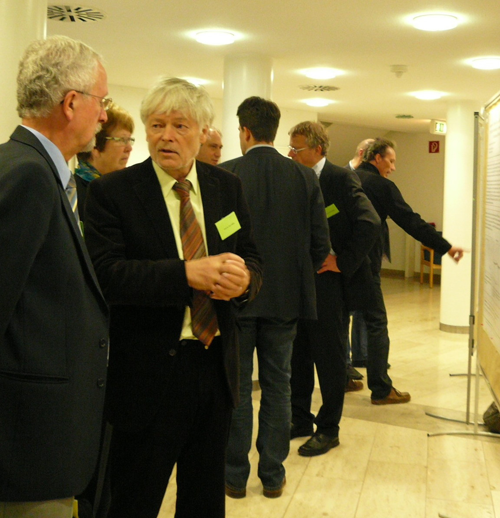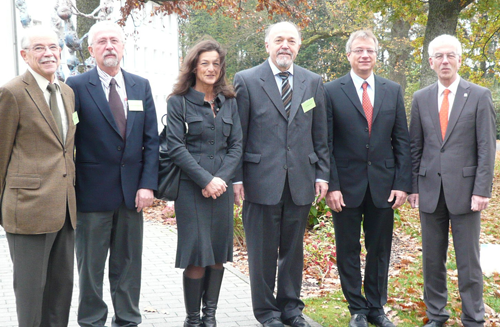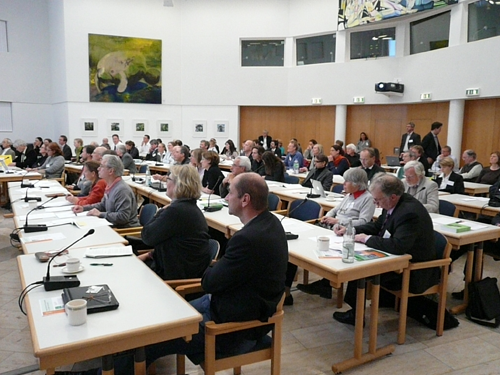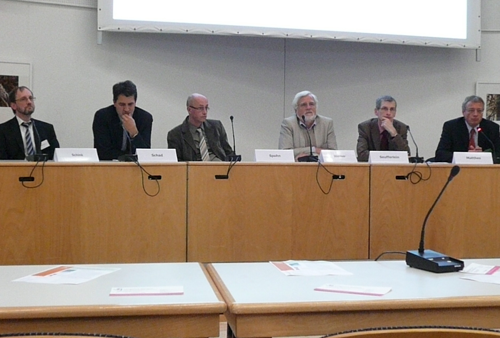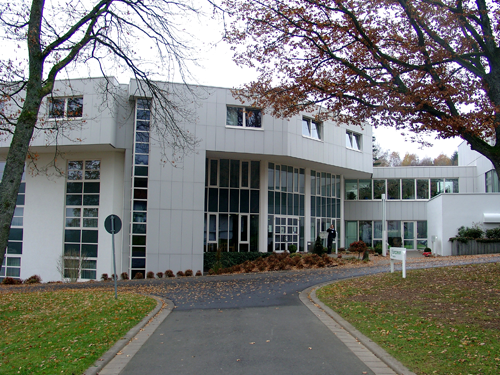"Every 4 years in Nonnweiler…"
Report of the 5th Mistletoe Symposium: "Mistletoe in Cancer
Therapy - Basic Research and Clinical Practice"
From 10th to 12th November 2011 about a hundred scientists and
doctors from a variety of scientific disciplines and therapeutic
approaches met at the European Academy of Otzenhausen (in
Nonnweiler, Saarland) for the 5th International, Interdisciplinary
Mistletoe Symposium. At the symposium, the latest results from
research and clinical medicine were presented, discussed and
compared, so as to put together a multidimensional and
comprehensive picture of the current state of scientific knowledge
on mistletoe extracts. Bridges were built not only between
different therapeutic approaches, pharmaceutics and medicine, and
basic research into mistletoe and use of mistletoe, but also
between conventional and complementary oncology. The treatment of
pancreatic carcinoma was chosen as a topic for special attention
and was dealt with in depth in a podium discussion both from the
perspective of conventional oncology and in terms of the
contribution which mistletoe preparations can make to the
management of this condition. In addition, the participants at the
symposium discussed and unanimously approved the wording of the
"Second Nonnweiler Declaration" (see box at end of article for
details). This declaration calls for the cost of parenteral
administration of mistletoe preparations not only in the palliative
but also in the adjuvant therapeutic setting to remain reimbursable
by the German statutory health insurance (SHI) funds.
The symposium was organised and sponsored by the Karl and
Veronica Carstens Foundation and the Society of Anthroposophical
Doctors in Germany (GAÄD) in collaboration with the Society for
Medicinal Plant and Natural Product Research (GA), the Society for
Phytotherapy (GPT), the German Pharmaceutical Society (DPhG) and
the Central Association of Doctors in Naturopathic and Regulation
Medicine (ZAEN), with the International Association for
Pharmaceutical Technology (APV) acting as a cooperation partner.
The scientific organising committee was made up of Prof. Dr.
Susanne Alban (Kiel), Prof. Dr. Hans Becker (St. Ingbert), Prof.
Dr. Wolfgang Blaschek (Kiel), Prof. em. Dr. Dr. h.c. mult. Fritz H.
Kemper (Münster), Prof. Dr. Wolfgang Kreis (Erlangen), PD Dr.
Harald Matthes (Berlin), Prof. Dr. Dr. h.c. mult. Heinz Schilcher
(Immenstadt) and Dr. Rainer Stange (Berlin). The symposium was
coordinated by Dr. Rainer Scheer, of the Carl Gustav Carus
Institute in Niefern-Öschelbronn.
A particular feature of this mistletoe symposium was the broad
range of topics covered, reflecting the breadth of current research
on this important medicinal plant. Pharmaceutical, pharmacological
and medical topics were presented by means of 8 summary papers, 24
short lectures and 19 posters. The specific areas dealt with
included pharmaceutical aspects of the manufacture of mistletoe
preparations and the effects of various constituents, in
vitro and in-vivo preclinical studies, studies on the
immunology and cytotoxicity of presently marketed or developmental
mistletoe preparations, clinical results obtained in various
applications and tumour entities in both adjuvant and palliative
therapeutic settings in both human and veterinary medicine, reports
from medical practice, and clinical studies designed to demonstrate
specific effects, the efficacy, the safety and tolerability of
mistletoe preparations. All the abstracts from the symposium have
been published in English in Phytomedicine (Elsevier-Verlag) 18
(2011), Supplement VIII and are freely available in the internet at
www.ScienceDirect.com.
The abstract booklets which are still in stock are available on
request from the author of this article. The following paragraphs
provide details of the summary papers and the topic of pancreatic
carcinoma.
As might be expected, the focus of the pharmaceutical
presentations was on mistletoe lectins, a class of substances
present in mistletoe extracts which jointly determine the effects
of these extracts. Professor Blaschek (Kiel) used
immunohistochemical methods to determine the localisation of these
lectins in the mistletoe plant and found differences in this regard
between tissues and seasons. He showed that mistletoe lectins are
mainly located in the shoots rather than the leaves, especially in
the cortical parenchyma and in the outer sclerenchyma caps of the
vascular bundles.
Based on the known structures of mistletoe lectins ML‑1 and ML‑3
(the molecular structure of ML‑2 remains unknown), Professor
Pfüller (Hamburg) discussed the biochemical and pharmacologically
relevant properties of these proteins, which specifically recognise
galactosyl/N-acetylaminogalactosyl target structures. In addition
to the ribosome-inactivating (cytotoxic) lectins, a chitin-binding
lectin (VisalbCBA) which is specific for glucosamine groups is also
known to exist. The biochemical properties, biological availability
and stability of the mistletoe lectins are influenced by other
components of mistletoe extracts (viscotoxins, oligo‑ and
polysaccharides).
Professor Klein (Tübingen) spoke about chronic and acute
inflammation and the dual role of inflammation in the pathogenesis
of cancer. A variety of immune and inflammatory cells are to be
found inside a tumour. These immunocompetent cells influence the
tumour cells in various ways (via cytokines, chemokines, growth
factors, prostaglandins and reactive oxygen and nitrogen species).
Inflammation influences every single step in tumorigenesis, from
tumour initiation and tumour maintenance to tumour progression and
metastasis. A rough distinction can be made between
tumour-destructive inflammation (TH1 response, M1 macrophages, NK
cells) and tumour-promoting inflammation (TH2 response, M2
macrophages). Both pro‑ and anticarcinogenic and inflammatory
mechanisms are present simultaneously in developing tumours, but if
the tumour is not eliminated, the procarcinogenic effects come to
dominate. Signal transduction pathways which promote the
procarcinogenic effects of inflammation often form a vicious
circle. Certain immune and inflammatory components can exert
positive effects on tumour growth during one stage of tumour
development, but negative effects during another stage. Treatment
with mistletoe preparations, which have long been reported to
stimulate a large number of factors that influence
(anticarcinogenic) tumour-associated inflammation via a variety of
mechanisms, can help break down immune tolerance to tumour antigens
and positively influence the immune response to tumours.
Nevertheless, the mechanism of such processes varies from tumour to
tumour, and only by continuously expanding our knowledge of the
complex interplay between different components of the anti-tumour
response will we be able to develop better strategies for treating
this disease.
In his talk, Professor Efferth (Mainz) reported on methods of
predicting response to cancer therapy and on the significance of
these for the development of personalised treatment strategies. In
this respect he discussed a range of subjects including relevant
cytotoxicity tests, immunohistochemical detection of prognostic
markers of therapeutic response and patient survival time, and
modern pharmacogenomic techniques (comparative genomic
hybridisation, DNA methylation assays, mRNA microarrays, etc.). He
compared data he had obtained using these techniques with clinical
patient data, and presented the results of investigations aimed at
predicting sensitivity or resistance both to cytotoxic agents and
to phytochemicals used in complementary medicine. In doing so he
emphasised the relevance of these methods to herbal medicines such
as mistletoe preparations.
Dr. Breitkreuz (Bad Liebenzell) reported on recent developments
in anthroposophical mistletoe therapy and on a series of expert
conferences hosted by the GAÄD between 2008 and 2011. By reference
to a number of case reports he discussed the topics considered at
those conferences, namely dosing strategies (initiation of therapy:
escalating dosage regimen or high initial dose), choice of host
tree, choice of preparation, control of mistletoe therapy and
methods of administration (subcutaneous, intravenous, intratumoral,
intrapleural, intravesical, oral), with reference to differences
between mistletoe preparations depending on their method of
manufacture. He also discussed questions such as how mistletoe
therapy and conventional therapy are coordinated and what should be
done in the event of critical treatment incidents or side effects.
In order to provide doctors who prescribe mistletoe therapy with
well-founded information, new study concepts (e.g. qualitative
studies) are being developed, data collection is being intensified
(Network of Oncology, Havelhöhe Research Institute) and plans are
underway for a new handbook (GAÄD, compilation of evidence on
therapeutic use of anthroposophical medicines), the third edition
(2013) of which is to include reference to mistletoe
preparations.
Dr. Kienle (Freiburg) provided an overview of clinical studies
on mistletoe preparations used in anthroposophical medicine and
phytotherapy. More than 140 such studies have been published, of
which 60 were prospective controlled studies. The study objectives
were to improve quality of life, patient survival, tumour response,
and safety and tolerability. Most of the studies yielded positive
results, but due to methodological differences in quality some
received more favourable reviews than others. One definite finding
is that mistletoe preparations improve quality of life and the
tolerability of conventional cancer therapies. Study data on safety
and tolerability show that after parenteral administration of
mistletoe preparations, side effects are mostly mild. Most common
among these are local reactions (skin reddening, induration at the
injection site after subcutaneous administration) and a slight rise
in temperature. Both of these types of reaction indicate to the
doctor that the patient is responding to the mistletoe therapy.
There have been occasional reports of pseudoallergic reactions, but
no reports of serious adverse reactions. Approximately equal
numbers of studies have been conducted in adjuvant and palliative
therapy settings. In recent years, regulatory authority demands
have increasingly led to the performance of (in most cases
randomised) clinical trials (RCTs), although many medical questions
cannot be answered on the basis of RCTs alone.
The question of studies also received a lot of attention in the
podium discussion on the main topic: "Treatment of pancreatic
carcinoma". In this discussion it was pointed out that RCTs
investigate the effect or efficacy of drugs in highly selected
patient groups, and do not always reflect real-world therapeutic
situations. For this reason, greater importance is likely to be
attached in the future to health services research and possibly
also to evaluation of registry data as a means of acquiring medical
and therapeutic knowledge. The Network of Oncology (NO; Havelhöhe
Research Institute, Berlin) will likewise become more important. At
present about 2000 patients per year are documented in the Network
of Oncology.
In his talk on "Options and limitations of ductal pancreatic
cancer treatment", Professor Seufferlein (Halle) pointed out that
pancreatic carcinoma has a very poor prognosis. The principal
reasons for this, he said, are firstly the lateness with which the
disease is diagnosed as a result of an absence of symptoms or the
presence of only nonspecific symptoms, and secondly the resistance
of the disease to radiotherapy and chemotherapy. Only complete
resection - which is, however, rarely possible - offers a
possibility of cure. In his talk, Professor Seufferlein dealt with
subjects ranging from neoadjuvant, adjuvant and palliative
therapies to new therapeutic strategies such as the use of CD40
agonists, which cause breakdown of tumour stroma and lysis of
tumour cells by macrophages. He also referred to albumin-bound
paclitaxel, which is used in the form of nanoparticles in
combination with gemcitabine, and to the acquisition of more
detailed knowledge of tumour subgroups, which it is hoped will
improve the efficiency of treatment. The following observations
apply only to adjuvant and palliative therapy settings. In Europe
the standard treatment in the adjuvant therapy setting is
chemotherapy alone. With this approach, the 5-year survival rate
has been increased from 9 to 20 percent. Because of its lower
toxicity, gemcitabine is preferred to bolus administration of 5‑FU,
although survival rates do not differ significantly between the two
drugs. In the palliative setting, gemcitabine prolongs survival and
relieves disease-related symptoms and signs such as pain and weight
loss. The median survival time of patients with metastatic
pancreatic carcinoma receiving this treatment is 6 to 7 months.
Combination of gemcitabine with erlotinib, an EGF receptor tyrosine
kinase inhibitor, improves this value (to 10.5 months) only in
patients who show an (inflammatory) skin reaction in the first few
weeks of treatment. Recently Conroy et al. showed that in patients
with metastases, intensified chemotherapy in accordance with the
FOLFIRINOX protocol increases median survival time to 11.1
months.
Dr. Matthes (Berlin) discussed the use of mistletoe therapy in
adjuvant and palliative therapy settings. In patients with
pancreatic carcinoma, mistletoe preparations are used
subcutaneously (as an adjuvant to chemotherapy), intravenously and
intratumorally in order to exploit the cytotoxic properties of
mistletoe extracts. Dr. Matthes reported on a controlled,
retrospective, multicentric, pharmacoepidemiological
noninterventional cohort study in which 396 postoperative patients
received conventional therapy with gemcitabine, while those
patients in the mistletoe arm (n=201) also received Iscador Quercus
subcutaneously. This led to an improvement in terms of quality of
life, symptoms attributable to the disease and its treatment and
overall survival in the mistletoe group as compared to the
comparator group. In a phase I dose escalation study by Mansky et
al. (Bethesda, USA), it was found that use of mistletoe therapy
with Helixor A in combination with gemcitabine in patients with
advanced solid tumours (n=44; pancreatic carcinoma n=10) was not
only well tolerated, but also higher doses of gemcitabine (as
recommended) were possible. The neutrophil granulocyte count and
its minimum value during chemotherapy showed a mistletoe
dose-depending increase. No influence whatsoever on the
pharmacokinetics of the cytotoxic drug or on cytokine release was
observed. Dr. Matthes also referred to smaller studies (Schad et
al., Berlin) in which patients with inoperable pancreatic carcinoma
were treated with intratumorally administered mistletoe
preparations of a number of different manufacturers simultaneously
with gemcitabine therapy. Overall survival time was subsequently
found to be 12.2 months in patients in UICC stage III and 11.2
months in patients in UICC stage IV, with a one-year survival rate
of 26 percent.
Outcome study data obtained by Dr. Spahn (monocentric
integrative therapeutic approach = indication-dependent combination
of conventional with anthroposophical therapy including mistletoe
extract, in most cases Abnobaviscum; hyperthermia) complemented and
confirmed these favourable results. The result was good tolerance
of treatment with a median survival time of 15.2 months in all
patients (n=95) and 12.4 months in patients with advanced disease
(stages III and IV; n=60). It was thus shown that an integrative
therapeutic approach involving use of mistletoe therapy leads to
results which are at least comparable to those obtained with purely
conventional therapy, but with better tolerance.
Last but not least, a randomised phase III study (Tröger,
Freiburg; Iscador Qu spezial) in patients with advanced or
metastatic pancreatic carcinoma was described in a poster. The
initial analysis of the results of this study is to be performed
shortly, so the papers to be delivered at the next Mistletoe
Symposium (2015) will be eagerly awaited. Another phase III study,
in this case in patients with superficial bladder carcinoma
(Eisenbraun, Pforzheim; Abnobaviscum Fraxini), is currently in
preparation. In addition, two prospective pharmacoepidemiological
studies on the use of Iscador Qu spezial in patients with
colorectal carcinoma (800 patients) and pancreatic carcinoma (400
patients) are being conducted at present.
As the symposium came to an end, all participants agreed that it
had been a great success, and the farewell words were "See you
again in four years' time in November 2015 at the 6th Mistletoe
Symposium in Nonnweiler."
The full texts of all contributions to the symposium are to be
made available, presumably by the end of 2012, in the form of a
book to be published by KVC Verlag Essen. Further information on
this and on previous mistletoe symposia is available at www.mistelsymposium.de.
24.11.2011 Dr. Rainer Scheer, Carl Gustav Carus-Institut, Am
Eichhof 30, 75223 Niefern-Öschelbronn
